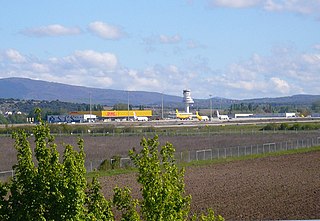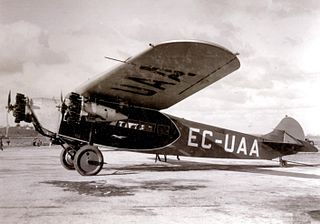Iberia, legally incorporated as Iberia Líneas Aéreas de España, S.A. Operadora, Sociedad Unipersonal, is the flag carrier of Spain. Founded in 1927 and based in Madrid, it operates an international network of services from its main base of Madrid–Barajas Airport. Iberia, with Iberia Regional and with Iberia Express, is a part of International Airlines Group. In addition to transporting passengers and freight, Iberia Group carries out related activities, such as aircraft maintenance, handling in airports, IT systems and in-flight catering. Iberia Group airlines fly to over 109 destinations in 39 countries, and a further 90 destinations through code-sharing agreements with other airlines.

Adolfo Suárez Madrid–Barajas Airport, commonly known as Madrid–Barajas Airport, is the main international airport serving Madrid in Spain. At 3,050 ha in area, it is the second-largest airport in Europe by physical size behind Paris–Charles de Gaulle Airport. In 2019, 61.8 million passengers travelled through Madrid–Barajas, making it the country's busiest airport as well as Europe's fifth-busiest.

Josep Tarradellas Barcelona–El Prat Airport, and also known as El Prat Airport, is an international airport located 15 km (9.3 mi) southwest of the centre of Barcelona, lying in the municipalities of El Prat de Llobregat, Viladecans, and Sant Boi, in Catalonia, Spain.
Air Nostrum, legally incorporated as Air Nostrum Líneas Aéreas del Mediterráneo, S.A., is a Spanish regional airline based in Valencia.

ENAIRE is the air navigation manager in Spain, certified for the provision of en route, approach and aerodrome control services. As a public corporate entity attached to the Spanish Ministry of Public Works, it is responsible for air traffic control, aeronautical information and the communication, navigation and surveillance networks - these are all necessary so that air companies and their aircraft can fly safely and in an organised format within Spanish airspace.

ASL Airlines Spain, formerly PAN Air Líneas Aéreas S.A., was a cargo airline based at Madrid–Barajas International Airport, Spain. Its main hub was at Madrid–Barajas International Airport with small hubs at Barcelona–El Prat, Seville, Valencia, Vitoria and Zaragoza.

Cygnus Air is a cargo airline based in Madrid, Spain. It is a privately owned airline operating scheduled flights to destinations mainly in Europe. Its main base is Madrid Barajas International Airport. Founded in 1994 as Regional Líneas Aéreas, it has undergone a number of name changes along its history.

Vitoria Airport is an airport near Vitoria-Gasteiz, in the Basque Country of Spain. Located in the Foronda district, it is also called Foronda Airport. The airport has one terminal with 3 gates, 7 check-in counters and 16 stands for medium and light aircraft, and a 3,5 km long CAT II/III runway.
Iberia Líneas Aéreas de España, S.A., usually shortened to Iberia, is the largest airline of Spain, based in Madrid.

The Spanish Republican Air Force was the air arm of the Armed Forces of the Second Spanish Republic, the legally established government of Spain between 1931 and 1939. Initially divided into two branches: Military Aeronautics and Naval Aeronautics, the Republican Air Force became the Air Forces of the Spanish Republic, also known as Arma de Aviación, after it was reorganized following the restructuring of the Republican Armed Forces in September 1936, at the beginning of the Spanish Civil War. This defunct Air Force is largely known for the intense action it saw during the Civil War, from July 1936 till its disbandment in 1939.

The Bréguet 26T was a French single-engine biplane airliner that first flew in 1926.

The Fokker F.XX was a 1930s Dutch three-engined airliner designed and built by Fokker. It was the first Fokker design to use an elliptical-section fuselage instead of the traditional square fuselage and the first Fokker aircraft with retractable landing gear.

Palma de Mallorca Airport is an international airport located 8 km (5.0 mi) east of Palma, Mallorca, Spain, adjacent to the village of Can Pastilla. In 2020, the airport handled 6.1 million passengers, making it the third busiest airport in Spain, after Madrid–Barajas and Barcelona-El Prat. The airport is the main base for the Spanish carrier Air Europa and also a focus airport for Eurowings, EasyJet, Jet2.com, Ryanair and Vueling. The airport shares runways with the nearby Son Sant Joan Air Force Base, operated by the Spanish Air and Space Force.

Jorge Loring Martinez was a Spanish engineer and entrepreneur, pioneer of civil aviation in that country, and considered by the Spanish Patent Office one of their great inventors. Grandson of businessman and politician Jorge Loring y Oyarzábal, he was born into a wealthy family which from the beginning of the century was dedicated to banking, mining, steel and railways.

Compañía de Líneas Aéreas Subvencionadas, meaning 'Subsidized Airlines Company', mostly known as CLASSA, was a Spanish airline based in Madrid, Spain.

Plus Ultra Líneas Aéreas S.A. is a Spanish long-haul airline based at Adolfo Suárez Madrid–Barajas Airport.

Lineas Aereas Canarias (LAC) was an airline created in 1984 to initially offer connections in the Canary Islands and excursions to Morocco and Madeira. It started operations in 1985 and ceased operations in 1990.

Universair was a Spanish airline with headquarters in Palma de Mallorca. The airline operated from 1986 to 1992.

















